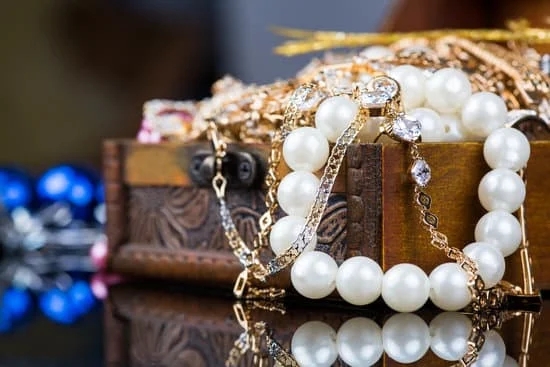Fine jewelry holds a special place in our hearts and has been treasured for centuries. From dazzling diamonds to lustrous pearls, it is the embodiment of luxury and elegance. But what makes fine jewelry truly authentic? In this article, we delve into the world of fine jewelry, exploring its definition, value, and significance.
First and foremost, it is essential to understand what constitutes fine jewelry. Unlike mass-produced costume pieces or fashion accessories, fine jewelry is crafted with genuine precious metals and gemstones. This distinction sets it apart from imitation or counterfeit pieces that attempt to mimic its splendor. Authenticity is key when it comes to evaluating the true worth of fine jewelry.
However, there are common misconceptions surrounding fine jewelry that can cloud consumers’ judgment. Some may believe that any piece adorned with gems qualifies as authentic, while others may be unaware of the vast difference in quality between genuine and imitated materials. Therefore, it is crucial for buyers and enthusiasts alike to educate themselves on distinguishing real fine jewelry from its counterfeit counterparts.
Indeed, the significance of authenticity cannot be understated when it comes to fine jewelry. Genuine materials not only enhance its aesthetic appeal but also contribute to its overall value. From the brilliance of a flawless diamond to the luster of a natural pearl, these unique characteristics add to the allure and desirability of fine jewelry. Moreover, consumers often prefer purchasing real pieces because they understand that they are investing in something valuable and enduring.
As we embark on this journey through the realm of fine jewelry, we will explore various aspects such as testing methods used to determine authenticity, certifications that ensure legitimation, identification of fake pieces in order to safeguard oneself from counterfeit issues, pricing factors that affect market value and more. Through this exploration, we hope to provide you with an insightful understanding of how real fine jewelry not only symbolizes quality but also contributes to a more sustainable and responsible industry.
So, let us delve deeper into the world of fine jewelry, embracing its authenticity as a symbol of timeless beauty, quality craftsmanship, and enduring value.
The Significance of Authenticity
When it comes to fine jewelry, authenticity holds immense significance. Authenticity refers to the genuine materials and craftsmanship used in creating each piece of fine jewelry, distinguishing it from imitation or counterfeit options. Understanding why real is better can greatly impact one’s buying decisions and overall experience with fine jewelry.
One of the key aspects that make authentic fine jewelry superior is its inherent value. Fine jewelry often features precious gemstones such as diamonds, rubies, emeralds, and sapphires. These natural gems exhibit unique characteristics and exceptional beauty that cannot be replicated by imitations. Genuine gemstones have higher clarity, color intensity, and durability compared to synthetic or lab-grown alternatives. The rarity and natural origins of these gemstones contribute to their high value in the market.
Moreover, real fine jewelry symbolizes quality and craftsmanship at its finest. Skilled artisans meticulously design and create each piece by hand, ensuring perfection in every detail. The use of high-quality metals such as gold or platinum also enhances the overall worth of fine jewelry. Authentic pieces are made to last a lifetime, passed down through generations as cherished heirlooms.
Consumers generally prefer real fine jewelry over imitation options due to several reasons. First and foremost, authentic pieces provide peace of mind for buyers who want assurance that they are getting what they pay for. When investing in fine jewelry, whether it be an engagement ring or a special necklace, knowing that it is genuine elevates its sentimental value.
Furthermore, real fine jewelry offers better long-term investment potential compared to counterfeits. Genuine pieces tend to hold their value or even appreciate over time due to various factors such as rarity, craftsmanship reputation, brand recognition, and market demand.
Testing Fine Jewelry
When it comes to investing in fine jewelry, it is crucial to ensure its authenticity. Luckily, there are various testing methods available that can help determine the genuineness of fine jewelry. These tests not only provide peace of mind for buyers but also serve as a means to validate the value and quality of the pieces they purchase.
One widely used technique to test the authenticity of fine jewelry is through gemstone testing. Gemstones are often a key component of fine jewelry, and their authenticity greatly affects the overall worth of the piece. There are several methods commonly employed for gemstone testing, such as:
- Visual Inspection: Skilled gemologists examine the stone by observing its color, clarity, and other visual characteristics. They compare these features to known genuine stones to determine if any discrepancies exist.
- Light Testing: Gemstones exhibit different behaviors when exposed to light. Techniques like refractometer and spectroscope can measure how light interacts with the stone, helping identify imitations or synthetic stones.
- Hardness Testing: Diamonds, for example, have exceptional hardness compared to other materials. The Mohs Scale of Hardness is often used to assess this property of gemstones and differentiate between genuine and fake options.
In addition to gemstone testing, hallmarking plays a significant role in authentication. Hallmarks are small markings made on precious metal items like gold or silver that indicate their purity or fineness. Hallmarking systems vary across countries, but they generally involve official stamps that certify the quality and composition of the metal used in jewelry.
By understanding these testing methods and techniques, consumers can confidently verify the authenticity of fine jewelry before making a purchase. This knowledge empowers them to make informed decisions based on genuine value and quality rather than being deceived by counterfeit imitations.
The Role of Certifications
Certifications play a crucial role in the fine jewelry industry, ensuring the legitimacy and authenticity of pieces. These certifications are issued by respected and well-established bodies that are recognized globally for their standards and expertise. The presence of certifications can provide consumers with a sense of trust and confidence when purchasing fine jewelry.
One of the leading certification bodies in the jewelry industry is the Gemological Institute of America (GIA). The GIA is known for its rigorous grading and certification process, particularly for gemstones such as diamonds. Their certifications provide detailed information about the color, cut, clarity, and carat weight of a diamond, allowing consumers to make an informed decision about their purchase. Other reputable certification bodies include the American Gem Society (AGS), International Gemological Institute (IGI), and European Gemological Laboratory (EGL).
Relying on certified jewelry offers peace of mind to buyers, as they know they are getting a genuine product. Certifications validate that the materials used in fine jewelry are authentic and meet certain quality standards. This is especially important when purchasing high-value pieces or investing in gemstones, as counterfeiting is a prevalent issue in the industry. Additionally, certifications serve as documentation for insurance purposes or in case of any future investments or resale.
| Certification Body | Description |
|---|---|
| Gemological Institute of America (GIA) | Known for rigorous grading and certification process globally. |
| American Gem Society (AGS) | Focuses on ethical practices and consumer protection. |
| International Gemological Institute (IGI) | A leading independent gemological laboratory worldwide. |
| European Gemological Laboratory (EGL) | A trusted certification body based in Europe. |
Common Counterfeit Issues
Counterfeit jewelry has been a prevalent issue in the market, with many consumers unknowingly purchasing fake pieces. Therefore, it is crucial for buyers to understand the common counterfeit issues and how to identify fake fine jewelry. This section will provide a detailed overview of the techniques used to produce fake fine jewelry, tips for spotting counterfeit pieces, and ways to safeguard against purchasing fakes.
One of the most common techniques used in creating counterfeit fine jewelry is the use of synthetic gemstones or imitations. Synthetic gemstones are man-made versions that possess similar characteristics and appearances as natural gemstones. While these synthetic gems can be legally sold as long as they are properly disclosed, unscrupulous sellers may intentionally misrepresent them as genuine gemstones.
Another common method for producing fake fine jewelry is through plating or coating. In this technique, a layer of precious metal such as gold or silver is applied to cheaper metals like copper or brass to give the appearance of a more expensive piece. However, over time, the plated or coated layer may wear off, revealing the inferior base metal underneath.
To protect oneself from purchasing fake fine jewelry, there are several tips and tricks that can be employed. Firstly, one should examine the quality of craftsmanship. Authentic fine jewelry is usually well-made with attention to detail and precision. Poorly finished edges or uneven settings could indicate a counterfeit piece. Additionally, it is essential to scrutinize any hallmarks or stamps on the jewelry for authenticity and accuracy.
| Common Counterfeit Issues | Identifying Fake Fine Jewelry |
|---|---|
| Synthetic gemstones | Inspect for any suspiciously perfect gemstones. |
| Plating or coating | Check for signs of wear or discoloration on the metal. |
| Poor craftsmanship | Look out for any imperfections or sloppy workmanship. |
| Inaccurate hallmarks | Verify the authenticity of the provided hallmarks. |
In order to safeguard against purchasing fake fine jewelry, consumers should educate themselves about reputable sources and brands. Researching and vetting sellers before making a purchase is vital. Reputable jewelers often have established credibility and customer reviews that can help validate their authenticity. Additionally, it may be beneficial to seek out certified jewelry as certifications provide an additional layer of confidence in the quality and authenticity of the piece.
By being aware of common counterfeit techniques and employing vigilant buying practices, consumers can protect themselves from investing in fake fine jewelry. The next section will discuss the price differences between authentic and counterfeit jewelry, emphasizing the importance of investing in genuine pieces for long-term value and satisfaction.
The Price of Fine Jewelry
The price of fine jewelry is undoubtedly a significant consideration for consumers. When it comes to authentic pieces, the value associated with them is often higher compared to their counterfeit counterparts. Understanding how authenticity affects the price of fine jewelry can provide valuable insights for those looking to make informed purchasing decisions.
Market Value and Pricing Factors
Authentic fine jewelry holds a higher market value due to several factors. One primary factor is the use of genuine materials, such as precious metals and gemstones. These materials are often sourced ethically, with strict quality control measures in place. The rarity and intrinsic value of these materials contribute to the overall price of the piece.
Additionally, craftsmanship plays a crucial role in determining the value of fine jewelry. Authentic pieces are typically handcrafted by skilled artisans who have honed their craft over years or even generations. The intricate details and exquisite finishes showcased in real fine jewelry demonstrate the dedication and expertise required to create such pieces, further increasing their value.
Difference in Price between Authentic and Counterfeit Jewelry
Counterfeit or fake fine jewelry may appear visually similar to its authentic counterpart but lacks the genuine materials and craftsmanship that command a high price tag. Due to using cheaper materials and mass production techniques, counterfeit pieces are typically sold at much lower prices compared to authentic ones.
It’s essential for consumers to recognize that opting for counterfeit jewelry based solely on its lower price comes at a cost beyond monetary savings – it means compromising on quality, durability, and potential investment value. Investing in authentic fine jewelry not only guarantees better craftsmanship but also preserves the integrity of your collection over time.
Factors that Contribute to High Price of Genuine Fine Jewelry
Various factors contribute to the high price tag associated with genuine fine jewelry. Firstly, reputable jewelers often invest in responsibly sourced materials, ensuring their ethical origins while supporting sustainable practices. This commitment adds value both from an environmental and social perspective.
Additionally, creating authentic fine jewelry involves a meticulous and time-consuming process. From designing to crafting, each step requires precise attention to detail and expertise. The labor-intensive nature of producing real fine jewelry contributes significantly to its higher price.
Lastly, the reputation and brand equity of established jewelry houses also play a role in determining the price of fine jewelry. Brands renowned for their quality, artistic designs, and craftsmanship often have a loyal customer base willing to pay a premium for their pieces.
Understanding how authenticity affects the value of fine jewelry empowers consumers to make well-informed choices when making purchases. By investing in authentic pieces that reflect genuine materials, exceptional craftsmanship, and responsible sourcing practices, individuals can create a collection that not only holds monetary value but also carries personal significance as heirlooms or symbols of style and sophistication.
Sustainable and Ethical Fine Jewelry
As awareness about the environmental and social impact of various industries grows, the demand for sustainable and ethical products has also increased. This shift in consumer values has influenced the fine jewelry industry, leading to the rise of sustainable and ethical fine jewelry.
Sustainable fine jewelry focuses on minimizing its environmental footprint throughout its lifecycle. This includes using recycled metals, responsibly sourced gemstones, and employing environmentally friendly manufacturing processes. By opting for sustainable fine jewelry, consumers can contribute to a greener industry and reduce their environmental impact.
Ethical fine jewelry goes beyond sustainability by addressing issues related to labor practices and human rights. It ensures that workers involved in the production of fine jewelry are treated fairly, paid a living wage, and work in safe conditions. Additionally, ethical fine jewelry seeks to avoid the use of materials that have been associated with unethical practices such as conflict diamonds or gemstones mined under exploitative conditions.
When purchasing sustainable and ethical fine jewelry, it is crucial to consider certifications or seals of approval from reputable organizations. These certifications provide assurance that the piece has met specific standards regarding sustainability and ethics. Some widely recognized certification bodies in the industry include Fairtrade Gold, Responsible Jewellery Council (RJC), and Ethical Making Pledge.
By choosing real sustainable and ethical fine jewelry, consumers can not only wear beautiful pieces but also make a positive impact on people and the planet. Supporting brands that prioritize sustainability and ethics encourages more responsible practices within the industry as a whole. It allows individuals to enjoy their favorite designs while aligning their personal values with their purchasing decisions.
Establishing Trust
Guiding readers on finding trustworthy jewelry retailers and brands
When it comes to purchasing fine jewelry, it is crucial to establish trust with the retailer or brand you are buying from. This ensures that you are investing your money in authentic and high-quality pieces. To find reputable sources for fine jewelry, there are several steps you can take.
Firstly, conducting thorough research is essential. Start by exploring well-known and established jewelry retailers or brands that have a positive reputation in the industry. Read customer reviews, check their certifications and memberships in recognized organizations such as Jewelers of America or the Responsible Jewelry Council. Look for additional information about their sourcing practices, craftsmanship, and after-sales services.
Additionally, seeking recommendations from trusted friends and family members who have purchased fine jewelry can be valuable. Their firsthand experiences can provide insights into trustworthy retailers or brands that they have had positive experiences with.
Importance of researching and vetting sellers before making a purchase
Before making any purchase, it is important to thoroughly vet the seller to ensure the authenticity of the fine jewelry. One way to do this is by checking if they provide detailed descriptions and images of each piece they sell. Genuine sellers often include specific information about the materials used, including type and quality of gemstones, metals, weight, dimensions, and any certifications associated with the piece.
Another aspect to consider when vetting sellers is their return policy. Reputable sellers generally offer clear and fair return policies in case you are not satisfied with your purchase or suspect any issues with its authenticity.
It is also worth looking into whether the seller has a physical store location or online presence beyond just a website. A physical store allows customers to see the pieces in person before making a decision while an online presence should include transparency regarding contact information like phone numbers and addresses.
Highlighting reputable sources for genuine fine jewelry
There are several well-known and trusted sources for genuine fine jewelry. One notable example is Tiffany & Co., renowned for its luxurious and timeless designs, high-quality materials, and impeccable craftsmanship. Other reputable names in the industry include Harry Winston, Cartier, and Van Cleef & Arpels.
In addition to internationally recognized brands, there are also local and independent jewelry designers who produce fine jewelry with authenticity and integrity. These designers often have a unique approach to their creations and can offer personalized pieces that reflect individual style.
It is important to note that while luxury brands may come with a higher price tag due to the prestige associated with their name, there are also reputable sources that offer high-quality fine jewelry at more affordable price points without compromising authenticity.
By researching sellers, vetting their credibility, and exploring reputable sources for fine jewelry, buyers can establish trust before making a purchase. Taking these steps not only safeguards against counterfeit or low-quality pieces but also ensures that you are investing in genuine fine jewelry that will retain its value over time.
Conclusion
In conclusion, fine jewelry holds a special place in the world of adornment and self-expression. It is important to understand the authenticity of fine jewelry, as it determines its true value. Throughout this article, we have explored the significance of authenticity, testing methods for determining genuineness, certifications that ensure legitimacy, common counterfeit issues, pricing factors, sustainable and ethical practices in the industry, and the importance of establishing trust when purchasing fine jewelry.
By investing in real fine jewelry, individuals are not just acquiring a beautiful piece of art but also a symbol of quality and value. Authenticity enhances the worth of fine jewelry, as genuine materials such as precious metals and gemstones possess unique characteristics that cannot be replicated by imitations. The craftsmanship and attention to detail that go into creating authentic pieces add to their allure.
Furthermore, purchasing real fine jewelry provides peace of mind through certifications from reputable bodies in the industry. These certifications validate the authenticity of the materials used and ensure that ethical sourcing practices have been followed. By supporting sustainable fine jewelry brands that prioritize responsible practices, consumers can contribute to a greener and more responsible industry.
When it comes to purchasing fine jewelry, it is essential to establish trust by researching and vetting sellers before making a purchase. By choosing trustworthy retailers or brands known for their commitment to quality and authenticity, buyers can be confident in their investment.
Frequently Asked Questions
Is fine jewelry worth buying?
Fine jewelry can be worth buying for a variety of reasons. Firstly, it often holds timeless value and can retain its worth over time. Fine jewelry is typically made using precious metals like gold, silver, or platinum, along with gemstones such as diamonds, rubies, or sapphires.
The craftsmanship and attention to detail in fine jewelry make it an attractive investment for those looking to pass down valuable pieces to future generations. Additionally, fine jewelry can be seen as a symbol of status and luxury, allowing the wearer to showcase their personal style and taste.
Is fine jewelry plated?
Fine jewelry is not typically plated. Plating involves applying a thin layer of metal onto the surface of a base metal piece through electroplating or other similar processes. Although plating can enhance the appearance of jewelry by giving it a desired color or finish, it does not increase its value or durability in the same way that solid precious metals do.
On the other hand, fine jewelry is made from solid precious metals and often incorporates genuine gemstones meticulously set by skilled artisans. This distinction adds to the allure and longevity of fine jewelry compared to plated pieces.
What jewelry is considered real?
Real jewelry refers to items crafted from genuine materials such as precious metals and natural gemstones or minerals. Gold, silver, platinum, and palladium are commonly used in real jewelry due to their intrinsic value and durability. These metals are known for their tarnish resistance and ability to withstand everyday wear without losing their luster or shape easily.
Likewise, real gemstones are sourced from nature rather than being artificially created in laboratories. They possess unique characteristics such as color, clarity, carat weight, and cut that determine their authenticity and desirability among discerning buyers. When evaluating whether a piece of jewelry is considered “real,” it is crucial to ensure that both the metal components and gemstones meet industry standards for authenticity and quality craftsmanship.

Welcome to my jewelry blog! My name is Sarah and I am the owner of this blog.
I love making jewelry and sharing my creations with others.
So whether you’re someone who loves wearing jewelry yourself or simply enjoys learning about it, be sure to check out my blog for insightful posts on everything related to this exciting topic!





